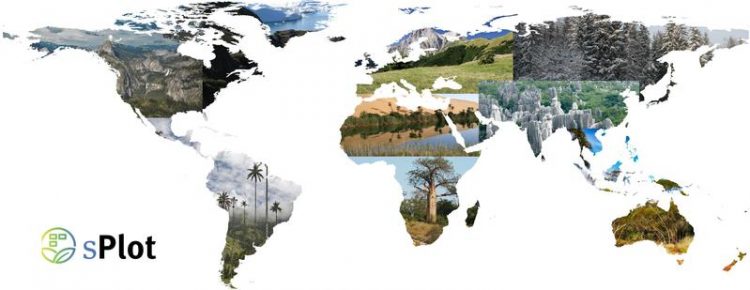From the Arctic to the tropics: researchers present a unique database on Earth’s vegetation

"sPlot" is the world's first global vegetation database which contains over 1.1 million complete lists of plant species for all terrestrial ecosystems. Francesco Maria Sabatini / MLU
All plants face the same challenges, whether they are small grasses, shrubs or trees. “For example, they have to find an efficient way to conduct photosynthesis in order to obtain the energy they need.
At the same time, they compete with neighbouring plants for limited resources in the soil, like water and nutrients,” explains Professor Helge Bruelheide from the Institute of Biology / Geobotany at MLU and co-director of iDiv.
Currently around 390,000 plant species are known to science. Over time, each species has developed very different traits in reaction to external factors at their location. These include the plant’s size, the thickness and the chemical constituents of its leaves.
These properties are also referred to as functional plant traits. “These functional traits directly influence a plant’s ecosystem function, such as how much biomass it produces or how much carbon dioxide it absorbs from the air,” says Bruelheide.
Until now, researchers have primarily investigated different combinations of these functional traits from the perspective of individual plant species. “In reality, however, plant species rarely occur alone; plants live in communities,” says Bruelheide.
Therefore, so-called vegetation databases are needed that contain data on all of the plants growing at a specific location. The German Vegetation Reference Database is an example. It is managed at MLU by Dr. Ute Jandt, a member of Helge Bruelheide's research group. It contains about data on about 200,000 vegetation plots from published and unpublished vegetation studies. Similar databases exist, or are being compiled, in many other countries.
Up until now there has been no database of databases, to compile and harmonize all these different datasets. As a result, the “sPlot” initiative was launched at the iDiv research centre to develop and set up the first global vegetation database, unifying and merging the existing datasets. “sPlot” currently contains more than 1.1 million vegetation lists from every continent, collected over the past decades by hundreds of researchers from all over the world.
“Each point in our database is a real place with precise coordinates and information about all the plant species that co-exist there,” explains Bruelheide.
The research group combined this massive dataset with the world's largest database for plant traits called “TRY” which is also an iDiv database platform. “It has enabled us to answer questions that nobody has been able to tackle before,” Bruelheide continues. The research tested, for instance, to what extent global factors influence the functional traits of plant communities.
Contrary to current opinion, they found that temperature and precipitation play a relatively limited role. “Surprisingly, these two macro-factors are not so important. Our analysis shows, for example, that plant communities are not consistently characterised by thinner leaves as the temperature increases – from the Arctic to the tropical rainforest,” says Bruelheide.
Instead the researchers found a close tie between climate variables and the phosphorus supply in the leaves, reflected in the ratio between nitrogen and phosphorus content in the leaf, which is an indicator of plants’ nutritional status. For example, the longer the vegetation period, the lower the phosphorus supply – which also affects leaf thickness.
Local land use and the interaction of different plants at a specific location have a much greater impact on the functional traits of plant communities. According to Bruelheide, these findings show that future calculations of plant production in a region cannot only be determined on the basis of simplistic temperature-precipitation models.
The study published in “Nature Ecology & Evolution” is the first of a series of upcoming papers by the “sPlot” consortium. Being available on request to other scientists, the “sPlot” database is disclosing unprecedented opportunities to tackle numerous biodiversity questions at the global scale, including the issues pertaining to the distribution of non-native plant species and the similarities and differences of plant communities across world regions.
Bruelheide H. et al. Global trait-environment relationships of plant communities. Nature Ecology & Evolution (2018). doi: 10.1038/s41559-018-0699-8
Media Contact
All latest news from the category: Ecology, The Environment and Conservation
This complex theme deals primarily with interactions between organisms and the environmental factors that impact them, but to a greater extent between individual inanimate environmental factors.
innovations-report offers informative reports and articles on topics such as climate protection, landscape conservation, ecological systems, wildlife and nature parks and ecosystem efficiency and balance.
Newest articles

First-of-its-kind study uses remote sensing to monitor plastic debris in rivers and lakes
Remote sensing creates a cost-effective solution to monitoring plastic pollution. A first-of-its-kind study from researchers at the University of Minnesota Twin Cities shows how remote sensing can help monitor and…

Laser-based artificial neuron mimics nerve cell functions at lightning speed
With a processing speed a billion times faster than nature, chip-based laser neuron could help advance AI tasks such as pattern recognition and sequence prediction. Researchers have developed a laser-based…

Optimising the processing of plastic waste
Just one look in the yellow bin reveals a colourful jumble of different types of plastic. However, the purer and more uniform plastic waste is, the easier it is to…



